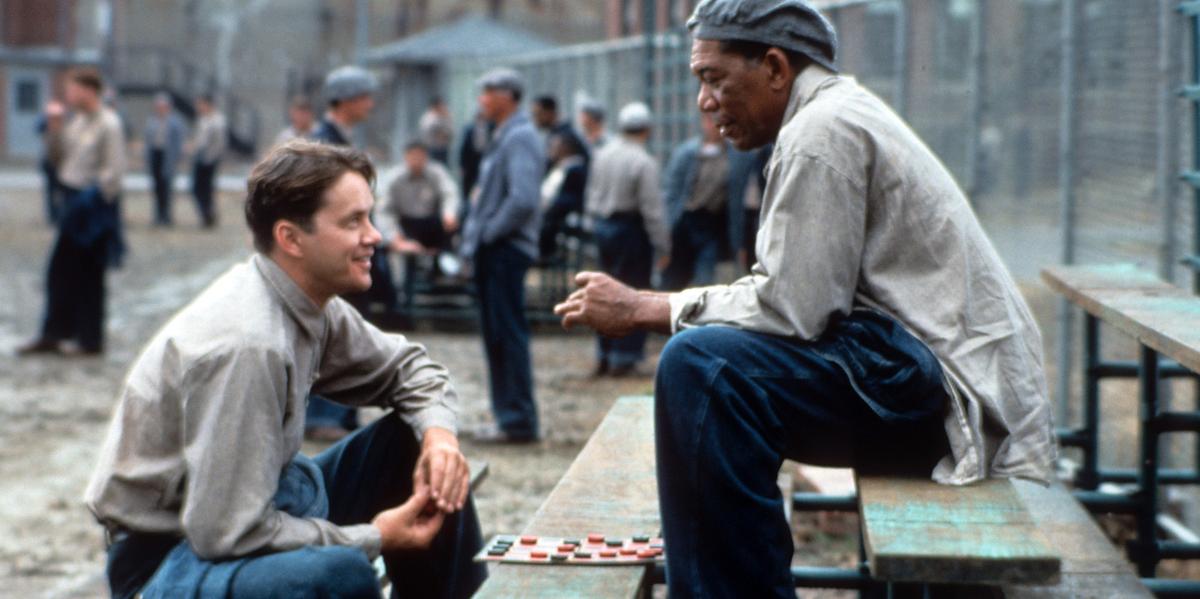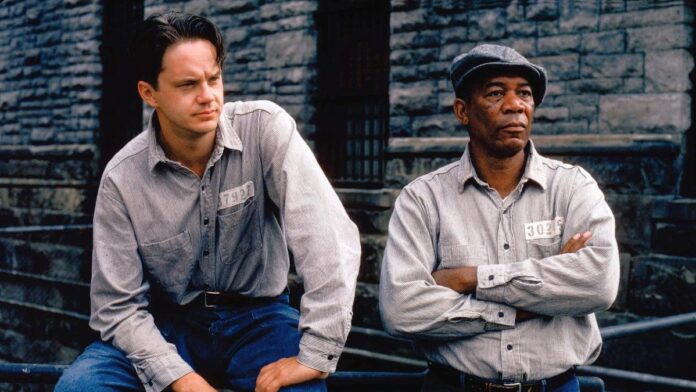In the October of 1994, multiple star-studded films faced off at the box office. Tom Hanks-starrer Forrest Gump was having a charmed box-office run, while Quentin Tarantino-directed Pulp Fiction also made its long-awaited debut.
Also on offer for the autumn movie-goer was the Morgan Freeman-Tim Robbins vehicle TheShawshank Redemption, directed by Frank Darabont. Based on the Stephen King novella Rita Hayworth and Shawshank Redemption (whose plot it follows quite faithfully), it was pitched as an inspiring jailbreak film; as its tagline it offered the uplifting missive: “Fear can hold you prisoner but hope can set you free.“
Unlike its companions, however, this movie proved to be a box-office bomb. Although nominated for seven Academy Awards, its Oscar campaign bore no fruit. But now, 30 years on, it has acquired cult-favourite status. Events were planned for the film’s anniversary this year, including a trail through the filming locations of the movie in August, primarily in Ohio. The line ‘Get busy livin’ or get busy dyin’ has trickled into popular consciousness, without any stamp of its origin. Its longevity has been attributed to cable television and home-video rentals— it became the most rented movie of 1995. Gradually, it acquired credibility through word of mouth, and is now regarded as a classic. And it has widely featured on lists of best films of the 90s and of all time. Even today, it occupies the top slot on IMDb’s top 250 and top 100 movies, indicating popular appreciation.
In the 30th year of the movie’s release, we watched it with fresh eyes, as a eager filmhound might have on some night in October 1994. And here is what we took away from it.
Entering Shawshank
The opening itself sets the tone for the movie: it is grim, a little hopeless. Andy Dufresne (Tim Robbins) is parked outside the house of his wife’s lover. As this intercuts with the courtroom scene that damns Andy to two life sentences, for the murder of his wife and her lover, the viewer is left in doubt as to what happened that night.
But no matter. In 1947, Andy arrives at the fictional Shawshank State Penitentiary. And it is here that Ellis ‘Red’ Redding (Morgan Freeman) is being denied parole again, as he has been for the past 20 years. As Red muses, Andy doesn’t quite fit in with the rest of the prison crowd. It is not his claim of innocence that sets him apart— “don’t you know, we’re all innocent here,” his co-inmates tease — it is something in his manner, a carelessness almost. Andy soon strikes up a camaraderie with Red, after approaching him for a rock hammer— a canon event in the film and the eventual architect of his escape.

Tim Robbins and Morgan Freeman sitting outside on the benches playing checkers and talking in a scene from the film
| Photo Credit:
ARCHIVE PHOTOS
The budding friendship at the film’s heart is woven through with the disturbing dystopia that is prison life. Some of the evilness in prison is overt: a worm in Andy’s first meal, the death of a prisoner beaten by the guards on his very first night, the scourge of repeated sexual assault by Bogs and his crew. Others are more insidious, hints of continuing evil without respite—evil through cut scenes, whispered words, and nebulous fear.
But the movie is not a prison documentary. It is a grim creation, but still remains a quasi-fantasy of life. If this were a newspaper article, perhaps, we wouldn’t receive a reprieve. But in Shawshank Redemption, there are moments of respite. There is a library, which grows to become big and beautiful. There is friendship, grown further through cold beers, Rita Hayworth and a slight hope of music within.
Andy Dufresne is a purveyor of hope, and his Zihuatanejo may as well be a stand-in for a paradise. It is fitting; he is, after all, the underdog hero. The smart banker who took the fall for a crime he didn’t commit. The inspiring prisoner who doesn’t sink into the quicksand of horror but creates a library, helps people get an education, and gets in the good books of the warden. And eventually, he escapes. In all aspects, he fits into the hero archetype.
But Red, played deftly by Morgan Freeman, could be any guy. He is too towering to occupy the friend archetype. He’s the omniscient narrator, perhaps: the knowing expert of every place, the man watching from by the wall, too hardened to seek respite or escape. He wants no trouble. He is trusted, but not trusted enough to be made a member of society again. Indeed, it is when he declaims his incapacity to become part of society in any way, that society allows him to rejoin it.
The redemption
As we come to realise, Andy has nothing to seek redemption for, but the film offers him the redemption for his non-sin. It offers redemption for the viewer as well, redeeming the world for them as it redeems men from prison. It seems to study the beginning of humanness after humanity has given up on you. Crimes committed or uncommitted, these are people lost to society, perhaps forever. What can survive, in this spare atmosphere? The story follows the after which many soft bellied products of civilisation may not want to follow too closely.

A famous shot from the film
We never find out what Red did, at least in the movie. He murdered someone, yes, but who? For what? The movie makes it irrelevant. His action of inhumanity doesn’t strip him completely of his humanness. It is a benefit not accorded to Tommy, a hardened criminal now prepared to attempt a life beyond his crimes. He even brings hope for Andy, in the form of evidence of his being innocent of the crime for which he has been imprisoned. But not all hopeful things are allowed to flourish in Shawshank.
A still from ‘The Shawshank Redemption’
Another uncomfortable question is this: who gets to be declared a fit member of society? And further, what is acceptable to society — a godly man or a good one, a person dressed in the trappings of respectability or a soul with integrity? Who is allowed to be a person, and not merely a number in a prison ledger? The film challenges the notion that crossing over the thin social line which separates the inmate and the average man on the street is reserved for a select few. We sense this feeling of exclusivity in the prison guards, as if evil cannot be done by them or to them, and the warden, whose personal remoteness from the dirty deeds of his engineering makes him feel safe. They are evil and power in a cursed dance, creating the writs that ensure that none can touch them — or so they believe.

One of the film’s keenest tragedies is how a man becomes a creature of habit, even in a cruel, inhumane place. As the inmates spend years shut away from society, some begin to prefer the certain horrors of the prison to the uncertain horrors of the outside world. They are institutionalized men now, used to the routine, the structure, the hierarchy even, of prison life. The outside world is random, and they enter it as the dregs of society, not as a Man Friday, as Red is in the prison, or a well-liked prison librarian, as Brooks Halten is before he is paroled.
But the film’s most striking assertion, perhaps, is that all persons are allowed to live a life — a flawed, wavering, trembling little life. Time in prison is wasted time, but life is still a shining fact worthy of conserving. Is this kinder than real life? After all, in real life, there is no certainty of the redemption of the sun on your face, wind in your hair, and the feeling of green growing things around you. But the creator is nicer. “Hope is a good thing, maybe the best of things. And no good thing ever dies,” says Andy. And, almost fearfully, we believe him.
In the clarifying light of 30 years later, it is unsurprising that the film didn’t do well in theatres. It really does not seem like the kind of film you see on an afternoon and then proceed with life as usual. It is also unsurprising that it has been one of the most rented films of all time. You mull over it, what it has given you, suggest it to someone you want to do well, like a nugget of passed wisdom. This is what it has been for three decades. And every year, new viewers will find it, like a hope-giving letter under a black rock that has no business being below an oak tree in Texas.
Published – October 18, 2024 04:43 pm IST
#Shawshank #Redemption #Hope #good
